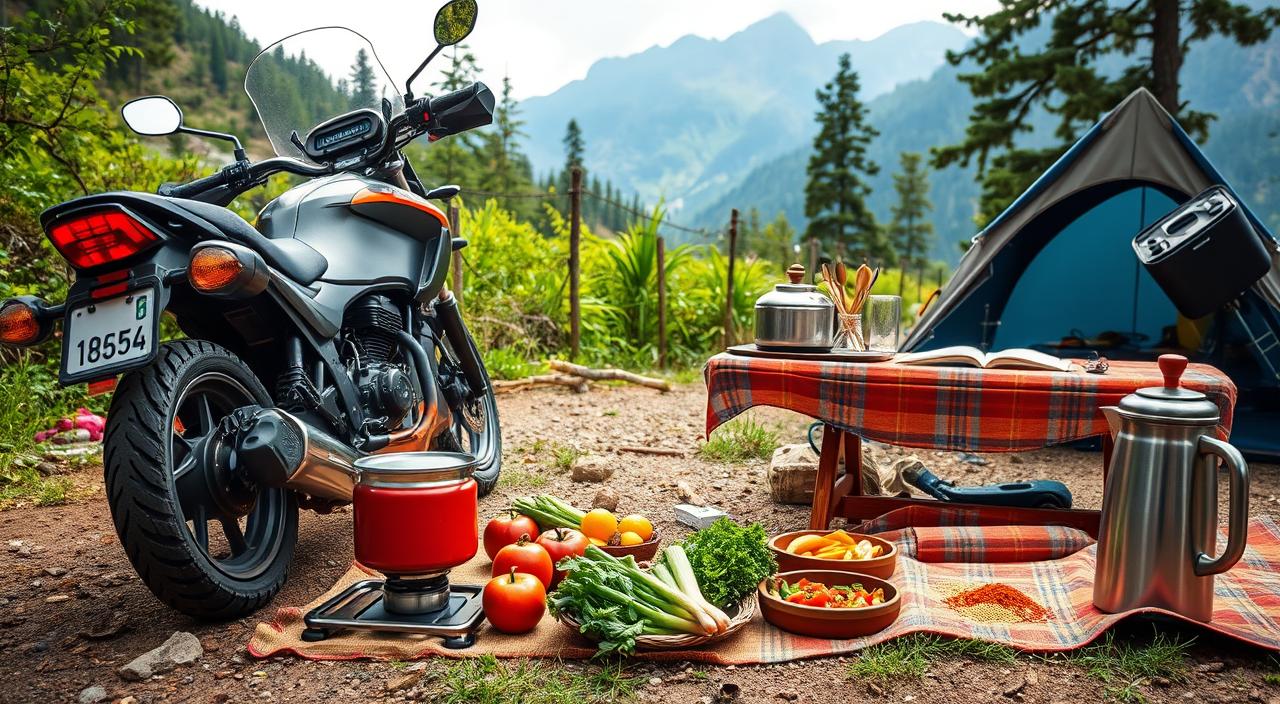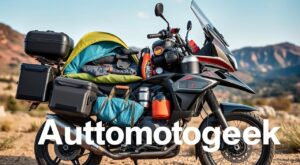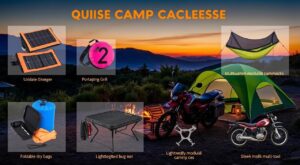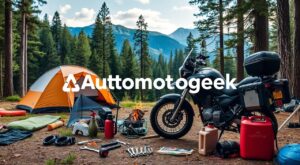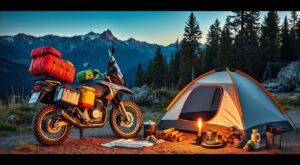As a motorcyclist, I’ve learned that camp cooking is a big part of motorcycle camping. It’s key to eat well, especially when you’re moving from city to wild nature. This guide offers tips on food and cooking for motorcycle camping. We’ll cover meal planning, the gear you need, and creative recipes to make your trip fun and tasty.
Key Takeaways
- Nutrition is crucial for sustaining energy while on long rides.
- Planning meals ahead can save time and resources during trips.
- Opt for lightweight cooking equipment to minimize your pack weight.
- Always carry enough water; hydration is vital for outdoor activities.
- Consider incorporating dehydrated meals for convenience on the road.
- Utilize public grills for cooking fresh meals in scenic locations.
- Fresh food storage can be tricky; buying along the way can help reduce waste.
The Importance of Nutrition While Motorcycle Camping
Nutrition is key when I’m on a motorcycle camping trip. It helps me stay energized, focused, and fully enjoy my journey. Without good food, I might feel tired, which could ruin the trip.
It’s important to plan healthy meals for the physical demands of riding. I choose foods that keep my energy up and avoid junk food that can make me crash. Since my motorcycle has limited space, I use compact cooking gear. I make simple, tasty meals in an hour to stay fueled without missing out on the adventure.
Many motorcycle campers feel the same way. About 70% of us cook our meals on the road for a sense of normalcy and comfort. For 85% of us, lightweight, durable cooking gear is a must. This includes portable stoves, often single-burner ones. Nutrition motorcycle camping means planning meals that truly nourish me.
Understanding nutrition while camping makes the trip better. With the right food and planning, I can hit the road with confidence. I know I have the energy to enjoy everything motorcycle camping offers.
Meal Planning for Motorcycle Trips
Planning meals for motorcycle trips means thinking about nutrition and convenience. I’ve learned that eating a variety of foods helps keep my energy up and me feeling good. It’s key to balance proteins, fats, and carbs to stay energized on long rides.
Balancing Nutritional Needs
While camping, I prefer quick meals made with real food over dehydrated ones, which can be pricey and full of sugar. Grocery store food is usually cheaper and better than eating out. For example, a lunch in Rockhampton might cost about $10 and offer healthy options.
It’s also important to know how much fuel you’ll need for cooking. In Australia, you can find methylated spirits and butane at gas stations, making cooking easy while traveling.
Creating Quick Meal Plans
I focus on meals that are simple to make and pack but still nutritious. Having some emergency rations ready is also smart for unexpected situations. Canned foods are great for keeping food fresh and saving money.
But, remember that light foods might not give you enough energy. Using public grills at picnic spots is a good way to cook meals that are both convenient and tasty.
| Meal Type | Options | Average Cost |
|---|---|---|
| Breakfast | Oatmeal, protein bars | $5 |
| Lunch | Grocery salad, canned tuna | $10 |
| Dinner | Pasta with vegetables | $12 |
| Emergency Rations | Energy bars, jerky | $15 |
Portable Camp Stoves: Choosing the Right One
When I go on motorcycle camping trips, picking the right portable camp stove is key. I look at fuel options, ease of use, and versatility. I’ve tried gas, petroleum, and alcohol stoves, each with its own pros and cons.
Gas stoves, like Coleman models, burn clean and have adjustable flames. They work well but can be tough in freezing weather. Petroleum stoves use various fuels and are reliable where gas is hard to find. For simplicity, alcohol stoves are easy to use but don’t heat as much as gas or petroleum stoves.
For motorcycle campers, stove weight and size matter. I aim to pack a light stove without losing cooking power. I also think about what I need while cooking on the go and avoid extra gear. The availability of fuel on my route is another important factor.
Keeping multi-fuel stoves in good shape is vital. Impurities in fuel can hurt performance. Gas stoves can produce carbon monoxide, so good ventilation is a must. I prefer stoves that heat well without too many fumes.
After years of motorcycle travel, I’ve found stoves like the MSR PocketRocket to be top-notch. They’re efficient and compact, letting me cook fast meals without losing flavor. I used to like the Whisperlite stove but moved to others after finding it hard to start. Now, I’ve tried the Coleman Micro stove, which boils water quickly, making it great for cooking on the go.
Camping Cookware Essentials
Starting a motorcycle camping trip requires the right gear. Quality camping cookware is key for making meals on the go. Since motorcycles have limited space, multi-functional cooking tools are a must. I find that choosing lightweight and compact cookware makes packing easier and keeps things organized.
Multi-Functional Cooking Utensils
Choosing multi-functional cooking utensils is crucial. Many tools can do more than one job, reducing the items I carry. For example, a spatula can also be used for stirring, and a spoon can be a serving tool. My camping essentials include:
- Small saucepan for boiling or simmering
- Durable fry-pan for frying and sautéing
- Compact grill grate for cooking over campfires
- Lightweight and sturdy plates that resist damage
- Multi-tool knife for chopping and food preparation
Recommended Cookware for Motorcycle Camping
I’ve found a few cookware items that are perfect for motorcycle camping:
| Cookware Item | Weight | Dimensions | Price |
|---|---|---|---|
| Primus Kinjia Stove | 8.2 lbs | 19” x 12” | Varies |
| AeroPress Coffee Maker | 0.5 lbs | 10.5” x 4.5” | $40 |
| Jetboil Flash Cooking System | 1.5 lbs | 4.1” x 8.0” | $130 |
These items help me set up an efficient cooking area for motorcycle camping. They’re lightweight and compact, fitting easily into my travel space. With these camping cookware essentials, I can make delicious meals on the go, enhancing my outdoor adventures.
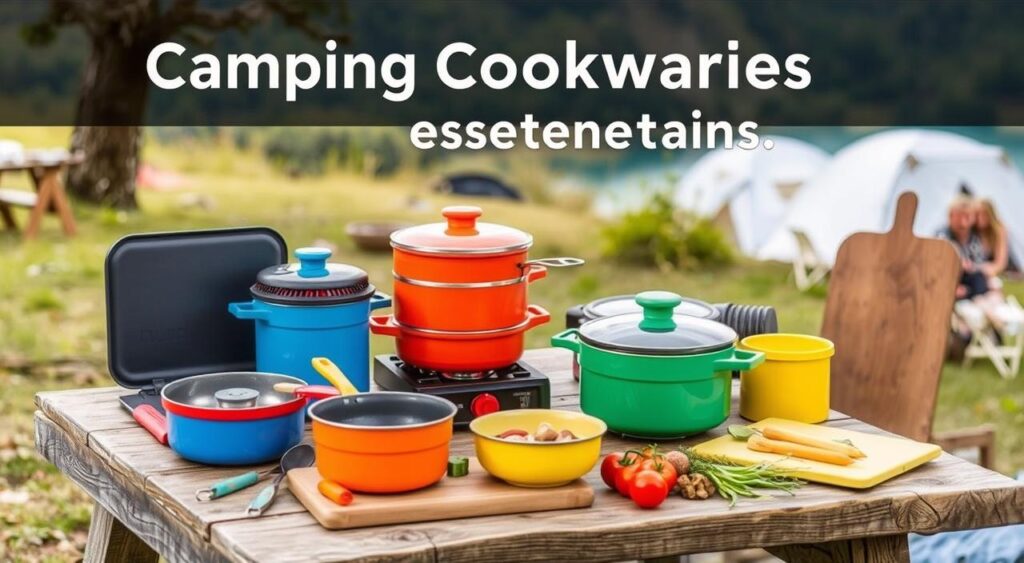
Food and Cooking Tips for Motorcycle Camping
When I go motorcycle camping, I find that practical food tips make a big difference. With limited storage, it’s key to pack only what you need. I always choose lightweight items that can be used for more than one thing. For example, a camping plate with raised edges can be a cutting board too.
Choosing a compact camp stove makes cooking easier, no matter the weather. I also carry versatile utensils to reduce what I need to pack. Water filtration tablets are a must for getting safe drinking water, which is crucial for enjoying meals on the go.
To make meal prep easier, I pack my ingredients carefully. Small travel-size bottles for things like oil and vinegar save space and keep me well-stocked. Buying fresh food at roadside markets helps avoid leftovers. Dehydrated foods are also a great choice because they’re easy to pack and provide important nutrients.
- Trail mix, nuts, and energy bars are great snacks for the road.
- All camping foods can usually be stored without refrigeration, making them easy to carry.
- Frozen water bottles keep food cool and can be used as a drink when thawed.
Keeping food clean is very important. I separate raw and cooked foods to avoid contamination. Organizing my food in different coolers keeps everything fresh. These tips have made my outdoor meals fun and energizing for my adventures.
Outdoor Cooking Techniques on the Road
Outdoor cooking techniques make motorcycle camping more fun. Using public grills and flat-tops lets riders cook warm meals with just a few tools. Parks and public areas often have cooking spots that are easy to use and fun.
Using Public Cooking Grills and Flat-Tops
Public grills are great for cooking on the go. They have lots of space and are meant for everyone to use. Using them saves space in your motorcycle and helps you meet other campers. You can get creative with your meals, from burgers to veggies.
It’s smart to bring important items like utensils and a cutting board. Don’t forget food that’s good for outdoor cooking.
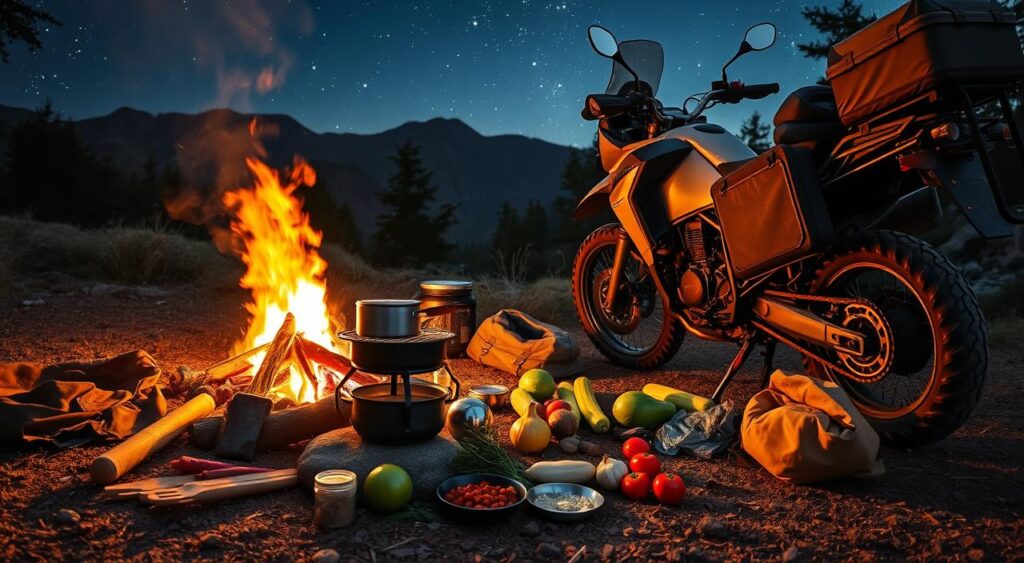
Efficient Fuel Usage and Fire Safety
Using fuel wisely is key when cooking outside, especially with portable gear. Knowing how to use less fuel makes cooking better and saves resources. Always check the fire rules where you’re camping to stay safe.
Keep things that can catch fire away from your cooking area. Having a fire extinguisher or water nearby is a must. These steps keep you safe, protect nature, and follow local laws.
Dehydrated Camping Food: A Practical Option?
Dehydrated camping food is a top pick for motorcycle campers who want convenience meals that are light and easy to carry. They last a long time and take up little space, making them great for long trips. But, it’s important to weigh the pros and cons of these foods to see how they affect your camping fun.
One big plus of dehydrated food is how easy it is to prepare and carry. You can quickly make meals like instant oatmeal or pasta with hot water. This means you can enjoy a warm meal without much work. But, the taste might not be as good as fresh food, which could make meals feel boring.
Having a variety of meals is also key. Some brands offer tasty options, but many meals can be the same and high in carbs. I like a mix of foods, like trail mix with nuts and seeds, to keep things interesting. Sometimes, I also bring snacks like baby carrots with hummus or dark chocolate to brighten my meals.
Here’s a quick look at dehydrated meals and other food choices:
| Meal Type | Advantages | Disadvantages |
|---|---|---|
| Dehydrated Meals | Lightweight, long shelf life, easy preparation | Bland taste, repetitive options, high-carb |
| Fresh Snacks (e.g., trail mix) | Customizable, better taste, nutrient-rich | Requires more packing space, shorter shelf life |
In conclusion, dehydrated camping food is convenient, but mixing in fresh snacks makes camping better. Choosing a mix of these options can make your trip more enjoyable and keep you healthy.
Healthy Motorcycle Camping Meals
Going on a motorcycle camping trip doesn’t mean you have to give up good food for ease. I’ve found many ways to make healthy meals that taste great and are easy to prepare on the go. The secret is to use real, raw, and unprocessed foods that fit a Paleo diet and are also affordable and easy.
Ideas for Quick Breakfasts
For quick breakfasts, I often choose oatmeal with avocado slices or a simple mix of pear, banana, and peanut butter. These meals are both healthy and give me the energy I need for riding. Fresh fruits like apples and pineapples are also great snacks to bring along, keeping me energized as I ride.
Delicious Lunch Options
Lunch is when I usually eat a more filling meal. I prefer sandwiches with quality proteins or salads made from local market ingredients. I like making tuna salads with cucumber and avocado for a fresh taste, or packing bell peppers with a filling to keep me fueled without feeling heavy.
Evening Meals That Satisfy
Dinner is a time to get creative with food. I often cook proteins like chicken or fish with veggies like zucchini and broccoli for a fulfilling meal. Sometimes, I make dishes like Hearty Steak Stew or Grandma Williams’ Goulash using easy-to-store ingredients. I finish with a kale ‘slaw to include a raw ingredient and keep things interesting. These meals make my camping cooking fun and satisfying.
